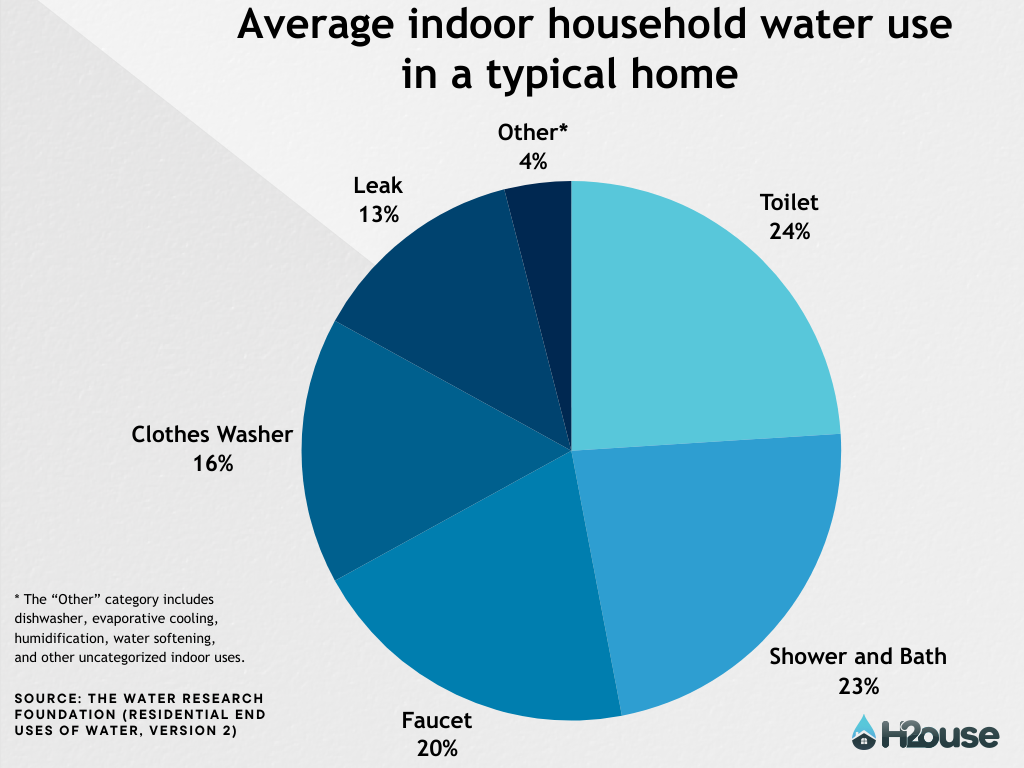Water is the most important natural resource on the planet. However, overpopulation and other issues have led to serious water shortages.
In America alone, the population has almost doubled in the past 70 years. At the same time, the country’s demand for water has more than tripled.
With water-related issues expected to continue growing, the need to preserve this resource has become more important than ever.
The good news about water conservation is that anyone can contribute from their own homes in a few simple ways.
What can you do?

Above: Toilets, showers, and faucets typically use the most water in a home. Leaks and other household uses can consume almost as much as clothes washers.
Check out: Top 5 Actions to discover some of the best ways to save water.
With droughts and overpopulation hurting our water supply, now is a great time to get involved.
At home
- Be more efficient with your toilet. About 24% of indoor water use comes from toilets. You should invest in a water-efficient toilet. If you use a standard toilet, which uses up to 5 gallons a flush, you can put a half-gallon plastic bottle filled with pebbles in your toilet tank to displace water.
- Install a low-flow shower head. These will save you fifteen gallons of water during a ten-minute long shower.
- Take showers instead of baths. It takes around 50 gallons of water to fill a bathtub, so a shower will always be more efficient. Using less hot water will also allow you to be more efficient with your water use.
- Use front-loading washing machines over top-loading machines. A front-loading machine will use around 20 gallons of water a load. Top-loading machines, on the other hand, use around 40 gallons a load. Energy Star rated washers that have a Water Factor lower than 3.2, use 33% less water than regular clothes washers per load.
- Use the right load size when doing laundry. Around 16% of indoor water use comes from laundry, so using the right load size will cut down on waste.
- Get an Energy Star dishwasher. Even though washing dishes uses a relatively small amount of water, you can still use more efficient machines. Energy Star machines use around 4 gallons a load, while other standard machines use 6 gallons. In comparison, hand washing your dishes takes about 20 gallons of water.
- By reading your water meter, you can discover if there are any leaks in your house. An average of ten gallons of household water a day is lost to leaks. This equals about 13% of your daily water footprint.
Bath | Kitchen | Laundry | Garage & Basement
Yards and pools
- It is estimated that around 60% of a household’s water footprint will go toward lawn maintenance. This includes any water needed for gardening as well.
- Living in a dryer area will require more water for your lawn or garden. However, you can still take steps to reduce how much you use.
- By planting drought-resistant lawns and plants outside your home you reduce the need to water them on a constant basis. There are numerous plants and shrubs that will thrive and grow with limited watering.
- Lawns should be watered during the hours of 10 p.m. and 6 a.m. (before dawn is best) and in short intervals. This leads to less evaporation and can save hundreds of gallons of water a year.
- An average pool will hold around 22,000 gallons of water. This alone is a huge investment of water resources. If you don’t cover your pool, evaporation will cause you to keep having to refill it. This can lead to thousands of gallons of wasted water every year.
- STEP 1: Plan your new landscape
- STEP 2: Choose the right plants
- STEP 3: Install efficient irrigation
- Swimming and soaking can be costly
- Lawn best ways to save and drought tips
- Lawn plant materials
- Irrigation systems best ways to save and drought tips
- Water-wise plants best ways to save and drought tips
Supporting water conservation
It is easy to start saving water from home. There are also a number of ways to get even more involved in water conservation.
Rainwater harvesting
Harvesting rainwater is a technique that allows for us to store and use water collected from rain. There are units that can catch and filter rain, then store the processed water. Installing these systems in homes would give families an efficient way to get water.
